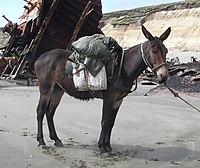
Can gypsy moth stand the heat? A reciprocal transplant experiment with an invasive forest pest across its southern range margin
Sign Up to like & getrecommendations! Published in 2018 at "Biological Invasions"
DOI: 10.1007/s10530-018-1907-9
Abstract: Temperature provides important physiological constraints that can influence the distribution of an invasive species. Gypsy moth (Lymantria dispar L.) is a generalist defoliator in North America and supraoptimal temperatures (above the optimal for developmental rate) have… read more here.
Keywords: range; gypsy moth; transplant experiment; reciprocal transplant ... See more keywords

Inversion frequencies and phenotypic effects are modulated by the environment: insights from a reciprocal transplant study in Coelopa frigida
Sign Up to like & getrecommendations! Published in 2018 at "Evolutionary Ecology"
DOI: 10.1007/s10682-018-9960-5
Abstract: Understanding how environmental variation drives phenotypic diversification within species is a major objective in evolutionary biology. The seaweed fly Coelopa frigida provides an excellent model for the study of genetically driven phenotypes because it carries… read more here.
Keywords: inversion; phenotypic effects; study; reciprocal transplant ... See more keywords

Adaptive, maladaptive, neutral, or absent plasticity: Hidden caveats of reaction norms
Sign Up to like & getrecommendations! Published in 2022 at "Evolutionary Applications"
DOI: 10.1111/eva.13482
Abstract: Adaptive phenotypic plasticity may improve the response of individuals when faced with new environmental conditions. Typically, empirical evidence for plasticity is based on phenotypic reaction norms obtained in reciprocal transplant experiments. In such experiments, individuals… read more here.
Keywords: transplant experiments; reciprocal transplant; plasticity; adaptive maladaptive ... See more keywords

A Reciprocal Transplant Experiment Confirmed Mite-Resistance in a Honey Bee Population from Uruguay
Sign Up to like & getrecommendations! Published in 2022 at "Veterinary Sciences"
DOI: 10.3390/vetsci9110596
Abstract: Simple Summary In Uruguay, as in many countries around the world, the Varroa destructor mite is the main biotic threat to honey bees (Apis mellifera). Most beekeepers regularly apply acaricides to their colonies to have… read more here.
Keywords: honey; reciprocal transplant; country; destructor ... See more keywords